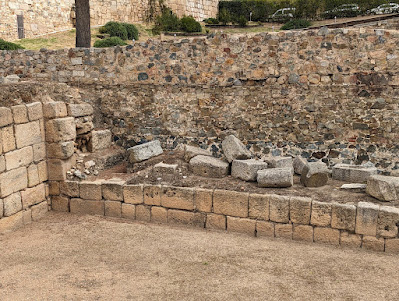We spent yesterday exploring around the city of Merida (originally the Roman regional capital of Emerita). Although most of the buildings in the city are relatively modern, it is built on top of what were major Roman and Moorish cities. Emerita was an important capital in the Roman empire over 2000 years ago. Scattered throughout the city are exposed excavations of ruins: baths, houses and other structures.
Here are the remains of baths (both cold and heated, per the nearby signage) in the middle of a block of modern houses and apartments.
The Rio Guadiana flows through the city. There are lovely parks and walking paths along the banks and on an island in the middle of the river.
Moreria is another archeological site. Here, original tile flooring from a Roman house.
The Alcazaba is the site of a former Roman settlement, then Moorish fort, near the river. There are sections of the original Roman roads, walls which were originally built by the Romans (the smaller stones) and later fortified by the Moors (larger granite blocks).
 |
| A small section of Roman road |
An underground cistern is connected with the nearby river to maintain a supply of water inside the fortifications.
 |
| Hard to tell in this picture, but those steps drop steeply to the water below. |
 |
| Carving around an entrance to the cistern |
 |
| An entrance to the antiteatro |
Later in the afternoon we visited an excavated site which was part of a Roman forum, and the Roman Temple of Diana. The latter started out as a Roman temple, was modified and expanded by Visigoths and later the Moors, and subsequently became part of a private residence.
Part of the forum:
And the Temple of Diana. The arched windows seen behind the columns are from the more recent period.
This morning we left Medina to continue our gradual tour toward Madrid. We stopped for walking and sightseeing in Cáceres and Trujillo, and arrived in the small town of Guadalupe late afternoon. More tomorrow....























No comments:
Post a Comment